I like puddles, and I have become more interested in them lately. Why?
On 29 May 2002, we took observations of the heating and moistening of the lower atmosphere using an aircraft and surface sites observations in the Oklahoma Panhandle (The Western Track in Figure 1). Two days before we took our data, a heavy rain brought 80 mm of rain to the point labeled 1, with the points labeled 2, 3, and 10 getting 30 mm or less.
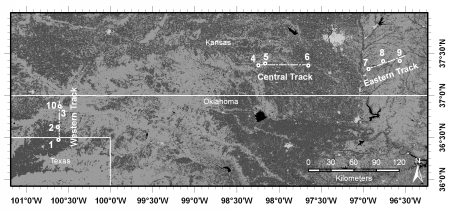
Figure 1. Map showing the location of aircraft flight tracks (white lines) and sites where we took special measurements (numbered 1-10). The observations I write about are along the Western Track, on the left side of the picture. The long white lines outline part of the state of Oklahoma.
We have been trying to see how well a land surface model would do in predicting the observed heating and moistening, given the weather conditions – temperature, solar radiation, wind, rainfall, and so on as input. And the model didn’t work very well near Site 1. No matter what we did.
We have an idea why: Puddles.
As you can see from Figure 2, there were puddles near the southern end of the flight track. In fact, one road was blocked by water. And the land surface model didn’t account for evaporation from puddles. We think this could explain why the measurements showed more moistening (and less heating) of the air than the model did.
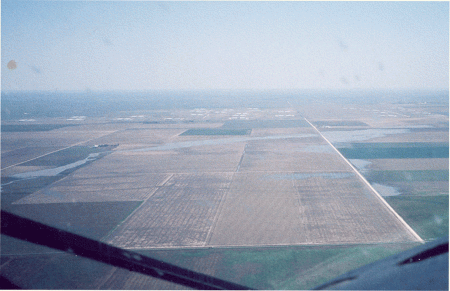
Figure 2. On 29 May 2002, photograph of puddles near the southern end of the Western Track, shown in Figure 1. The spots are on the aircraft windshield.
I decided that I had better learn more about puddles. So the first day there were puddles outside my office, I went outside and took puddle temperatures with a GLOBE infrared sensor (see the GLOBE Surface Temperature Protocol).
I was surprised – the puddles were warm compared the ground around them. This is not what I expected. Puddles like those in Figure 2 were cooler than the surrounding ground on 29 May. So I became even more excited about puddles. There is nothing more fun – and sometimes more awful! – than taking measurements you don’t understand.
I’m starting this project by just trying to figure out how fast the puddle disappears. On an asphalt surface, this tells me how fast the puddle evaporates. I’m also measuring the temperatures of the surface around the puddles.
Figure 3 is a picture of the puddle that I measured. The chalk rings are drawn around the puddle so that I can see how fast it is drying out.
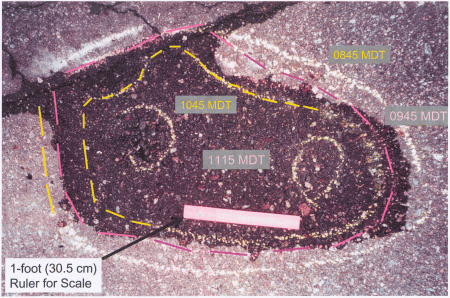
Figure 3. Puddle with outlines of water’s edge. The lines alternate between light yellow and light pink. Yellow or pink dashed lines are where the chalk is too light to see easily. By the time this picture was taken, the puddle was almost gone, with shallow water in a few places in the small left circle. Times are when the lines were drawn. UTC = MDT + 6 hours.
What did I learn? Figure 4 showed results more like what I had expected. As the sun got higher in the sky, the asphalt surrounding the puddle warmed more than the puddle itself. And the difference between the puddle temperature and the asphalt temperature got bigger, until around 11 a.m., when it started to get cloudy. After that, the temperature difference became smaller.
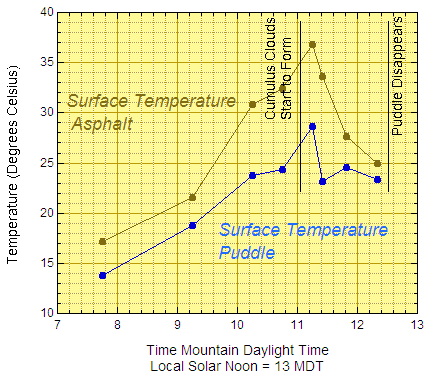
Figure 4. Temperature of the puddle in Figure 3 as a function of time. The skies were mostly clear until about 11 a.m. MDT. After that, the sky got cloudier with time. It was overcast by 11:50. Local solar noon (when the Sun is highest in the sky) is around 13 MDT.
Does this offer a clue to why the first puddle I looked earlier at was warmer than the surrounding surface? I think it does. That day, it was also cloudy in the afternoon.
If this puddle had lasted longer, AND if this puddle cooled more slowly than the dry asphalt once the skies were cloudy, then this puddle might have ended up warmer than the asphalt. And maybe it has something to do with the fact that water stores heat well.
So I need to look at more puddles. And, while doing this simple experiment, I noticed that I could have done some things better:
- I didn’t want to use the oven mitt on the radiation thermometer, as recommended for the GLOBE Surface Temperature Protocol, so I kept the radiation thermometer outside so that its temperature was the same as the air temperature. But I soon discovered that the air temperature where I kept the radiation thermometer was different enough from the puddle site that the measured surface temperature changed rather rapidly for about five minutes (the differences weren’t that bad). So I’m not too sure about the temperatures before 8 a.m. After 8 a.m., I still left the instrument outside but oven mitt on – and the measurements were more consistent.
- Toward the end of the observations, I realized that I had made a bad assumption: that all the asphalt outside the puddle was the same. It wasn’t. The puddle was in a place that had been repaired. You can see the difference in Figure 5. The area to the north of the puddle was up to 3 degrees cooler than the area to the south of the puddle! ). So I only use the temperatures on the south side in Figure 4.
- I had carefully drawn chalk rings around the puddle, so that I could see how fast it evaporated. But I forgot to take an important observation – how deep the puddle was! So – even though I could tell that the puddle was evaporating, I couldn’t tell how much water was evaporating – and I wanted to know that.
- If clouds are important, as they would be if the puddle stays warm after the skies cloud over, but the surface around it cools off – I need to be more careful about writing down when there were clouds.
- Fourth, once the puddle got quite shallow, it was basically wet asphalt. I should have taken the temperature of the wet asphalt as well.
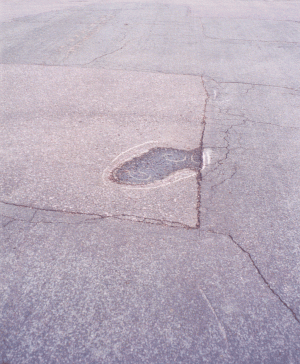
Figure 5. The puddle and its environment. Note the puddle lies on the south (right) end of an asphalt square that was slightly warmer than the darker asphalt to the right. (Although dark things are usually warmer than white things, the warm temperature could have something to do with different materials being used, or the thickness of the asphalt layer.)
I have some of the other data below. You’ll notice I may have made a few mistakes! (It’s important to keep track of them, so you can learn from them). The times are important because I might want to check other weather data I can get from the Web or from the automatic weather station on top of our building.
Next time I will be more thorough. I’ll let you know what happens. In the meantime, think about how you can use measurements or simple observations to describe some things that are happening around your home or school.
Table: Puddle measurements on 6 May 2007.
| Time (LDT) | Cloud | Comments |
|---|---|---|
| 0743 | Clear | Photos 7:50 of puddle. |
| 0845 | Clear | First Ring |
| 0945 | - | Second Ring; took photo. |
| 1045 | 0.4 Cu | Drew third ring; took photo |
| 1115 | Broken Cu | Drew 3 yellow circles where water still is. Got cloudy after second reading. Photo. |
| 1125 | - | Puddle almost gone. I take temperature measurements just to show how much they vary around and in where the puddle was. |
| - | - | Note temperatures on patch of asphalt to the north are cooler than temperature on the original asphalt to the south. |
| 1150 | Cloudy | Used average temperatures just for south for time series since just started taking measurements to the north (don’t have complete record). |
| 1220 | Cloudy | I recorded a temperature north of the puddle that was warmer than the temperature to the south of the puddle. I wonder if the readings are just reversed? |
| 1225 | Cloudy | Puddle basically gone |

Hello, Dr. Lemone. Interesting study being discussed here. I don\’t have any sort of expertise in this area at and all and any comment I make is only the speculation of a layman in this very complex field.
It seems that the puddle made it\’s biggest retreat from 10:45AM – 11:15AM. It might be useful to measure the volume of the puddle by bringing some containers of water and seeing how much water has to be poured into them in order to fill up the puddle, and then try to estimate the volume of the water (Y-axis) and how much of it continually evaporates as time passes (the x-axis). Perhaps then, maybe it could be discerned if the puddle is disappearing at a continuous rate or at an accelerate rate at some point, and what other event coincides with a faster acceleration rate.
Linus
Hi, Linus!
This is a great idea. Even if I had measured the depth, since the puddle shape was so complex.
One problem — the chalk I used to outline the puddle wore off quickly. So I either need to …
1. Create an artificial puddle of a simple shape, or
2. Use something that stays around a little bit longer (but not too long, since puddles tend to form int he same place again and again).
Thanks for your comment!
Peggy
Hi Peggy, This is very interesting and your experiments look fun. Puddles are transient and, if large enough, should be accounted for as you suggest. However, I think ‘permanent’ but widely spaced moisture sources are more important, as we have discussed, and chief among them are lakes and riparian zones. We have that lake study from CASES 97 that never got analyzed. Maybe acceptance of my NASA proposal will allow a first look at riparian zones from historical aircraft data.
Keep up the good work. This is definitely ‘shade-tree’ science at its best.
Your old buddy, Bob Grossman
I think it would be great to study that lake! Puddle temperature is a strong function of puddle size — something I didn’t talk about in the blog. I measured several puddles one sunny day after it rained, and the smaller puddles were warming up faster than the big ones, and the irrigation ditch, which was getting water from the lake, was much cooler.
Thanks, and good luck!
This is terribly fascinating and your experiments look fun. Puddles area unit transient and, if giant enough, ought to be accounted for as you recommend
As an Oklahoman (Tulsa) I have to say this data is pretty fascinating. You must love your work. Good job!